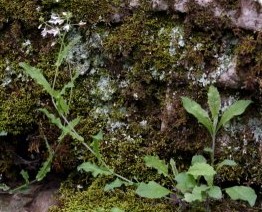Braun's rockcress facts for kids
Quick facts for kids Braun's rockcress |
|
|---|---|
 |
|
| Conservation status | |
| Scientific classification | |
| Genus: |
Boechera
|
| Species: |
perstellata
|
Boechera perstellata (also known as Arabis perstellata) is a very rare flowering plant. People often call it Braun's rockcress or Nevada rockcress. It belongs to the mustard family. This plant grows naturally in Kentucky and Tennessee. There are only about 25 known groups of these plants left. Many of these groups have only a few plants, and their homes are shrinking. Boechera perstellata likes to grow in shady forests on limestone rocks, usually near streams or rivers. Because it is so rare, the United States government lists it as an endangered species. This means it is protected by law to help it survive.
What Does It Look Like?
This rockcress is a perennial plant. This means it lives for more than two years. It is a herb, which means it has soft stems, not woody ones like a tree. Its stems can grow up to 80 centimeters (about 31 inches) long. They often spread out sideways and can hang over rocks or cliffs.
The plant's leaves grow in two ways. Some leaves form a circle at the bottom, called a basal rosette. Other leaves grow one after another along the stem. The stems and leaves look gray-green. This color comes from tiny, white, star-shaped hairs that cover them.
The flowers grow in a cluster called a raceme. This is a type of inflorescence where flowers grow along a central stem. Each flower has four petals. They can be white or a light purple color, and they are only a few millimeters long. After the flowers, the plant produces a fruit called a silique. This is a long, narrow pod, about 1.5 to 2 centimeters (about 0.6 to 0.8 inches) long. It is also hairy and holds tiny reddish seeds inside.
Where Does It Live?
Some scientists believe there are two types, or varieties, of Boechera perstellata. One type, called var. perstellata, is mostly found in Franklin County, Kentucky. It grows near the Kentucky River. The other type, var. ampla, is only found in Tennessee.
However, other scientists think these differences are not enough to call them separate varieties. They believe any small differences in the plants might just be because of their local environment.
Why Is It Endangered?
Even though this plant can sometimes grow in places that have been disturbed, like next to roads, too much disturbance is a big problem for it. Things like new buildings (development), land washing away (erosion), and cutting down trees (logging) can destroy its home.
Other dangers come from plants that are not native to the area. These are called non-native plants. Some of these are also invasive, meaning they spread quickly and take over. Two examples are garlic mustard (Alliaria petiolata) and amur honeysuckle (Lonicera maackii). These plants compete with Boechera perstellata for space, sunlight, and nutrients, making it harder for the rare rockcress to survive.


